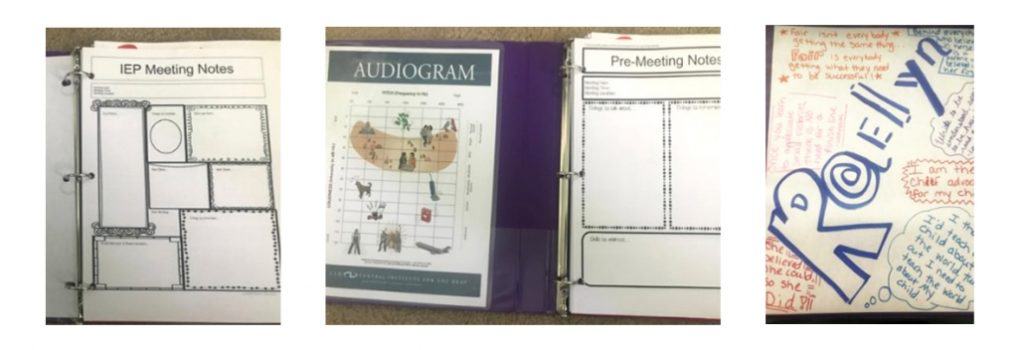As a teacher of the deaf and the parent of a daughter with hearing loss, I understand the importance of being prepared for IEP meetings. I was the parent of a child with hearing loss before I was a teacher, and when I first began attending IEP meetings, I often felt overwhelmed and underprepared. I needed to find a solution that would work for my family. My solution was to organize all of our information in a binder. When I carry this binder into a meeting, I feel powerful, prepared and ready to advocate for my child’s needs. Here is what I include in my binder:
- The cover: I decorated the cover of the binder with quotes that help me feel strong, such as, “I thought I would teach my child about the world; it turns out I need to teach the world about my child.” I wrote them in bright colors so that when I look at them, I feel joyful.
- Familiar Sounds Audiogram: I have a laminated copy of the Familiar Sounds Audiogram in the front of the binder so I can easily access it to help unfamiliar team members understand how my child hears and what sounds she misses.
- Current audiogram: Behind the Familiar Sounds Audiogram, I house a current audiogram.
- IEP preparation: I found this gem on Pinterest. I love this page because it encourages me to think about and write down questions, concerns and my daughter’s successes before the meeting.
- Meeting notes: This page was also found on Pinterest. It is helpful because I have a place to write down any new information, questions or contacts in the meeting.
- Acronym and definition: I found this page on Teachers Pay Teachers. This was especially helpful at the beginning of our journey when I was too nervous in a meeting to ask what an acronym meant. I would glance at the page so I could understand what the professional was saying in a meeting.
- Contacts: I include all team members’ contact information (name, title, email) on one page and make sure it stays current.
- IEP and updates: I include current and past IEPs in the binder so I can reference them as needed.
- Testing reports: These are important to keep so I can make sure that my daughter’s needs are being met based off of collected data.
- Procedural safeguards: This is a document that is important to have and be familiar with in case I feel that my daughter is not getting what she needs based on IDEA.

IEP meetings can be overwhelming and stressful, but they don’t need to be. Just as every child is different, so is every parent. Find what works for you so that you have the confidence needed to be your child’s best advocate.
For additional information, download free CID materials including an audiogram. You can also access this list of free IEP acronyms and definitions.













